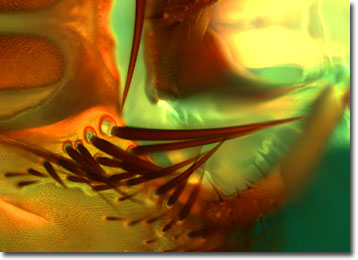Fluorescence Digital Image Gallery
House Fly Mouth
The often maligned common house fly, Musca domestica, is considered to be a nuisance as well as a vector for many diseases affecting both humans and animals. This is due largely to the eating habits of this species, which consumes and contaminates just about anything and everything, using its feet to touch every potential food item to see if it tastes good. Fruit, sewage, candy, or rotting garbage; they're all equally delicious to a house fly. In the process of tasting everything, of course, the fly also contacts a multitude of bacteria and viruses.

Although some flies can bite, the house fly cannot. Its mouthparts consist of soft, spongy structures called the labella and proboscis. The labella gently dab liquids into its proboscis, which then sucks up the liquid. If the fly encounters solid food it wants to eat, it drops saliva onto it, turning the food into a liquid.
House flies are among the speediest of insects with an average speed of about five miles per hour (mph) with bursts to 15 mph when threatened. The rapid beating of their wings (about 1,000 times per second) is responsible for the buzzing noise that accompanies a close fly-by. The sensitive antennae of the fly are responsible for detecting both food sources and changes in air currents that signal the approach of potential predators.
The life span of a typical fly is about 21 days, but they can live much longer in cool weather, although their metabolism and active movement is severely reduced. The average fly is about 0.15 to 0.25 inches in length, and they range from gray to dark brown with dark stripes on the thorax. The abdomen is colored yellow on the sides, and the eyes are often red or green. The larvae are cylindrical white maggots that average about 0.4 inches in length and taper off at the ends. Puparia are reddish-brown and are about half the size of the larvae.
The specimen presented here was imaged with a Nikon Eclipse E600 microscope operating with fluorite and/or apochromatic objectives and vertical illuminator equipped with a mercury arc lamp. Specimens were illuminated through Nikon dichromatic filter blocks containing interference filters and a dichroic mirror and imaged with standard epi-fluorescence techniques. Specific filters for the fly mouth specimen were a UV-2E/C, B-2E/C, and a Y-2E/C. Photomicrographs were captured with an Optronics MagnaFire digital camera system coupled to the microscope with a lens-free C-mount adapter.
BACK TO THE FLUORESCENCE DIGITAL IMAGE GALLERY
